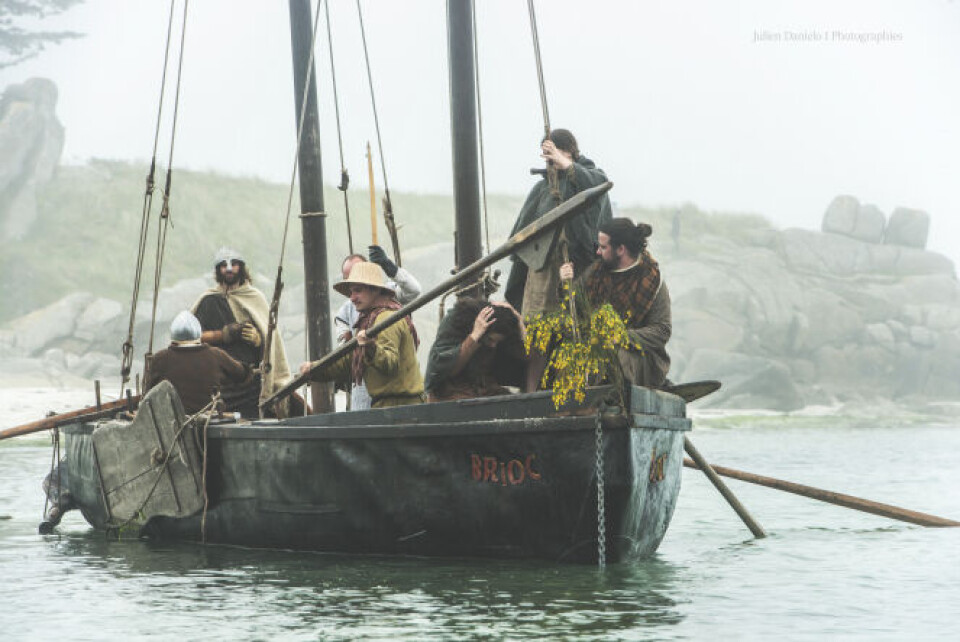-
Dunkin’ doughnut chain to open in France in May
Its flagship store will be in Paris’ ninth arrondissement
-
Proposed law will stop French banks from closing accounts for no reason
The legislation has sparked debate over financial regulations
-
Health reimbursements linked to income supported by French state auditor
The controversial move aligns with prime minister's plans to cut costs
‘Mediaeval’ French boat to sail from Brittany to Scotland
The replica of a tenth-century boat is made of wood and cowhide, and the crew will forego modern luxuries during the voyage

A group of history enthusiasts are planning to sail a boat built in the style of the Middle Ages from Brittany to Scotland in honour of their shared Celtic heritage.
The boat, named Brioc, is made from wood and leather with linen sails, and its sailors will be dressed in wool, linen and leather. They will aim to recreate the conditions of a 10th-century voyage, including cooking on an open fire lit using flint in a stone trough.
The association, Gward an aod, was hoping to make the journey last summer, but reached its funding targets too late, so instead used the time to ready the vessel, preparing new sails which were hand-stitched, and training the crew.
They are now planning to set sail next summer, and will sail via Wales, the Isle of Man and Ireland, replicating the historical trade between the Celtic nations.
“Mediaeval navigation is all about waiting for the right moment to set off. We have no motor, just oars and sails, so we mustn’t take any risks,” said Ingwenog Jaouen, the boat’s captain.
Boat is named after a Welsh holy man
The boat is named after Saint Brioc, a Welsh holy man who settled in what would later become Brittany. He also lent his name to Saint-Brieuc, the town in which the replica boat was built in the 1990s.
Brioc is a currach, a type of Irish boat over which animal skins or hides are stretched, upon which the founder saints of Brittany are said to have travelled from Wales and Cornwall.
In the end, Brioc never made it out to sea, and was more or less forgotten, passing between several individuals and associations who tried to find a use for it. And then came Mr Jaouen, one in a long line of sailors in his family.
“I went to see it and fell in love,” said Mr Jaouen, who already had an interest in the Middle Ages.
“Where we live in Brittany is still called the ‘Pays pagan’, and we are brought up with legends of seafarers who crossed the sea in stone troughs, or other mystical tales.”

The boat has already undertaken a tour of Brittany’s coastline. Photo credit: Gward an aod.
After undertaking a first set of repairs, he and his friends set off on a tour of Brittany’s coastline and canals.
At this point, they were paying less attention to historical accuracy – the sails for example were made of plastic – but from this first test, the potential was obvious.
“There is no rigid structure, it’s all very supple, which means the waves do not come and crash against the boat, but deform it and pass underneath. It’s a boat which holds very well when out on the sea.”
Once they reached the canals where there was less risk, they decided to use only historical equipment.
“Every step towards historicity brought us more comfort. By lighting a fire, we could warm up and cook more quickly and easily. That convinced us we had to push for more historicity.
“As our woollen clothes were not waterproof like modern clothes, we might have been worried about being too cold. In fact, with woollen clothes, we could be soaked but stay warm.
Important question of type of underwear
“At the beginning, we got caught in a storm and struggled to warm ourselves up. We realised we needed to avoid linen underwear, as this was reserved for the aristocracy in the Middle Ages, and we needed to use woollen underwear instead to stay warm – and it worked.”
Thanks to researchers in the team, they also had information about hygiene practices from the era.
The difficulty, Mr Jaouen said, was not so much to do with everyday life but more to do with navigation.
“Not having an engine in case of problems means having to anticipate and think a lot, but it’s also an advantage as it sharpens your senses as a sailor. What we lose in audacity we gain in good sense.
“It also requires a lot of physical effort when you have to row for several hours or even an entire day.”
The idea behind the voyage to Scotland is a symbolic one: they will collect the plans of a boat which was used in Scotland in the Middle Ages, and which also corresponds to the type of boat used in Brittany. They then plan to build the boat upon returning to France.
They also plan to make several stops on the way and participate in demonstrations and re-enactments. The association is hoping to produce a film documenting the adventure.
Both the boat and the association are based in Kerlouan (Finistère).
Related articles
Celtic nations descend on France to celebrate shared ancestry
Find medieval knights and monsters painted on Narbonne palace ceiling
The ‘moving rock’ off coast of Marseille is actually a boat
























